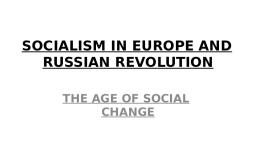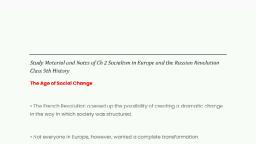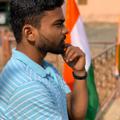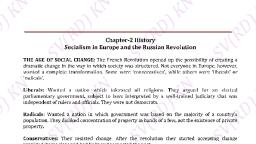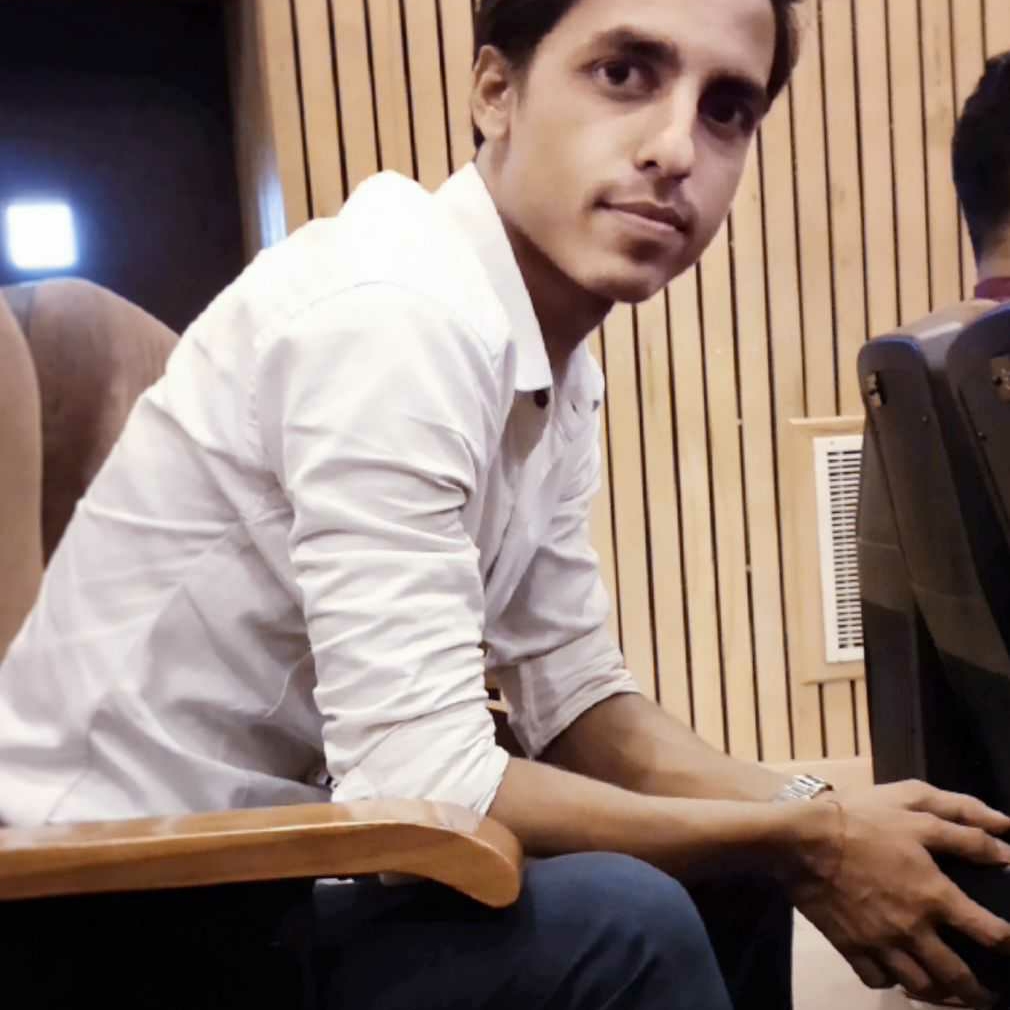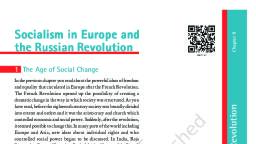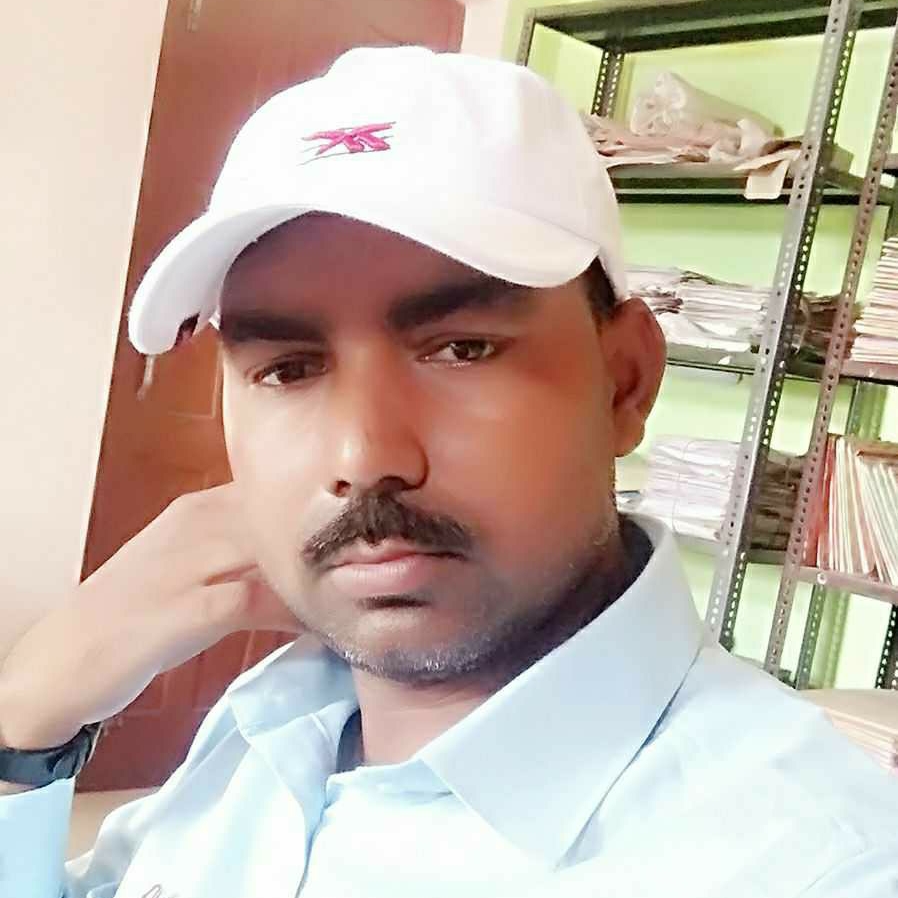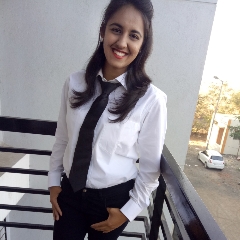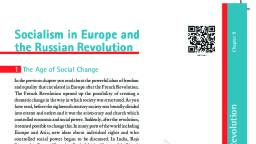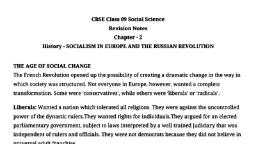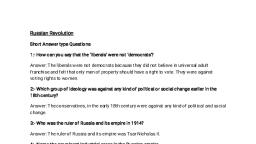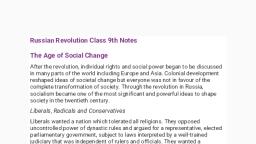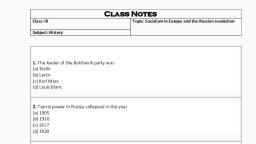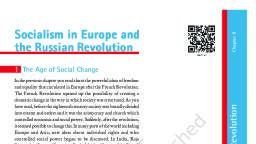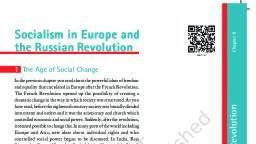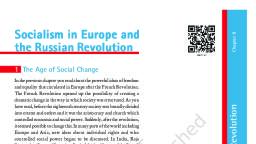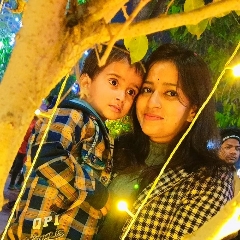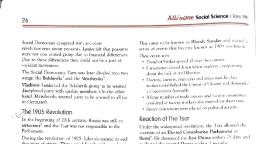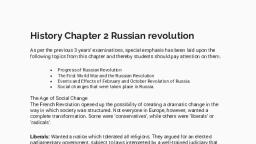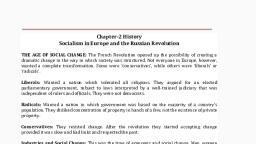Page 1 :
THE RUSSIAN REVOLUTION
Page 2 :
The Russian Empire in 1914, Russian socialists took over the government in Russia through the October revolution of 1917. The fall of monarchy in February and the events of October are normally called the Russian Revolution., The Russian Empire in 1914: In 1914, Tsar Nicholas II ruled Russia and its empire. It included current day Finland, Latvia, Lithuania, Estonia, Parts of Poland, Ukraine , Belarus , central Asian states, Georgia, Armenia and Azerbaijan., The majority religion was Russian Orthodox Christianity., Catholics, Protestants, Muslims and Buddhists were other religions .
Page 4 :
Economy and Society., 85% of Russian people were agriculturists. The proportion was higher than in most European Countries. Cultivators produced for the market as well as for their own needs and Russia was a major exporter of grain., In the countryside, peasants cultivated most of the land. But the nobility, the crown and the Orthodox Church owned large properties., Except in few cases they had no respect for the nobility. Peasants wanted the land of the nobles to be given to them. Frequently they refused to pay rent and even murdered landlords., They pooled their land together periodically and their commune(mir) divided it according to the needs of individual families.
Page 5 :
Economy and Society., Industry was found in pockets. Prominent industrial areas were St Petersburg and Moscow., Craftsmen undertook much of the production, but large factories existed alongside craft workshops. In 1980s many factories were setup due to expansion of Russian railway network and increased foreign investment. Coal production doubled and Iron and steel output quadrupled. , By 1900s in some areas factory workers and craftsmen were almost equal in number.
Page 6 :
Economy and Society, Most industry was the private property of industrialists. In craft units and small workshops, the working day was sometimes 15 Hrs, compared with 10 or 12 Hrs in factories. Accommodation varied from rooms to dormitories., Workers were a divided social group. Some had strong links with the villages from which they came. Others had settled in cities permanently., Workers were divided by skill. Metalworkers considered themselves aristocrats among other workers. Women made up 31 Percent of the factory labour force by 1914 with low wage compared with men.
Page 7 :
Economy and Society, Divisions among workers showed themselves in dress and manners too. , Some workers formed associations to help members in times of unemployment or financial hardship but such associations were few., Despite divisions, workers did unite to strike when they disagreed with employers about dismissals or work conditions., These strikes took place frequently in the textile industry during 1896-97, and in metal industry during 1902.
Page 8 :
Socialism in Russia., The Russian Social Democratic Workers Party was founded in1898 by socialists who respected Marx’s ideas. However it had to operate as an illegal organization as political parties were illegal before 1914. It set up a newspaper, mobilised workers and organised strikes., Some Russian socialists felt that the Russian peasant custom of dividing land periodically made them natural socialists. So peasants , not workers , would be the main force of the revolution, and Russia could become socialists more quickly than other countries., Socialists were active in the countryside through the late nineteenth century. They formed the Socialist Revolutionary Party in 1900. It struggled for peasants’ rights and demanded that land to be transferred to peasants.
Page 9 :
Socialism in Russia., Social Democrats disagreed with Socialist Revolutionaries about peasants. Lenin felt that peasants were not one united group. Some were poor and others rich, some worked as labourers while others were capitalists who employed workers. So they could not all be part of a socialist movement., Social Democratic Workers Party was divided over the strategy of organisation. Vladimir Lenin who led the Bolshevik group thought that in a repressive society like Tsarist Russian the party should be disciplined and should control the number and quality of its members. Others (Mensheviks) thought that the party should be open to all.
Page 10 :
The 1905 Revolution, In the beginning of twentieth century Liberals in Russia campaigned to end autocracy. Together with Social Democrats and Socialists Revolutionaries they worked with peasants and workers during the revolution of 1905 to demand a constitution. They were supported by nationalists and Muslim dominated areas by Jadidists who wanted modernised Islam to lead their societies., The year 1904 was a particularly bad one for Russian workers. Prices of essential goods rose so quickly that real wages declined by 20 percent. Membership of workers associations rose dramatically., In 1904, four workers were dismissed at the Putilov Iron Works leading workers strike at St Petersburg with the following demands:
Page 11 :
The 1905 Revolution, Reduction in the working day to eight hours, An increase in wages, Improvement in working conditions, When the procession of workers led by Father Gapon reached the Winter Palace it was attacked by the police and Cossacks where 100 workers were killed and about 300 wounded. This incident was known as Bloody Sunday, started a series of events that became known as the 1905 Revolution ., Strikes took place all over the country and universities closed down . Lawyers, doctors, engineers and other middle class workers established the union of unions and demanded a constituent assembly.
Page 12 :
The 1905 Revolution, During the 1905 Revolution Tsar allowed the creation of an elected consultative Parliament or Duma. Trade unions and factory committees were formed and made legal for a brief while., After 1905 , most committees and trade unions worked unofficially, since they were declared illegal. , Severe restrictions were placed on political activity., The Tsar dismissed the first Duma within 75 days and re elected second Duma within three months., He changed the voting laws and packed the third Duma with conservative politicians., Liberals and revolutionaries were kept out.
Page 13 :
The First World War and the Russian Empire, In1914 war broke out between two European alliances- The central power ( Germany, Austria and Turkey) and France, Britain and Russia., Each country had a global empire and the war was fought outside Europe ., In Russia the war was initially popular., War in the eastern front different from that on the western front., Impact on Industry.
Page 14 :
The February Revolution in Petrograd, The layout of the Petrograd city seemed to emphasise the divisions among its people., In February 1917, food shortage were deeply felt in the workers quarters., On 22 February a lockout took place at a factory on the right bank. On 23, workers in fifty factories called a strike in sympathy led by women., On 25 February government suspended the Duma.
Page 15 :
The February Revolution in Petrograd, On 27 government tried to control the situation and called the cavalry, but they refused to fire on the people. By the evening soldiers and striking workers had gathered to form a Soviet or council in the same building as the Duma met. This was the Petrograd Soviet., On 2nd march Tsar abdicated . Soviet leaders and Duma leaders formed a provisional Government to run the country. Petrograd had led the February Revolution that brought down the Monarchy in Feb 1917.
Page 16 :
AFTER FEBRUARY, Army officials, landowners and industrialist were influential in the Provisional Government., Restrictions on public meetings and associations were removed., Soviets like the Petrograd Soviet were set up everywhere , though no common system of election was followed., Vladimir Lenin, the Bolshevik Leader returned to Russia from his exile in April 1917.He and the Bolshevik Party was against the war since 1914. Now he felt it was the time for Soviets to take over power.
Page 17 :
AFTER FEBRUARY, Lenin’s April Theses : He declared –, (a) The war to be brought to a close, (b) Land be transferred to the peasants, (c) Banks be nationalized, He also argued that the Bolshevik Part rename itself the Communist Party to indicate the new radical aims. Initially they were supported the Provisional Government. But the developments of the subsequent months changed their attitude.
Page 18 :
AFTER FEBRUARY, Through the summer the workers movement spread. Factory committees were formed which began questioning the way industrialists ran their factories., Trade unions and Soldiers committees were formed., In June about 500 Soviets sent representatives to an All Russian Congress of Soviets., As the Provisional Government saw its power reduce and Bolshevik influence grow , it take the following actions :- (a) Resisted the attempts by workers to run factories, (b) Arresting leaders (c) Repressed the demonstrations staged by Bolsheviks ., Many Bolshevik leaders had to go into hiding or flee.
Page 19 :
AFTER FEBRUARY, In the countryside peasants and their Socialists Revolutionary leaders pressed for a redistribution of land. Land Committees were formed to handle the issue of redistribution of land. Encouraged by the Socialists Revolutionaries , peasants seized land between July and Sept 1917.
Page 20 :
The Revolution of October 1917, As the conflict between The Provisional Government and the Bolsheviks grew Lenin feared the Provisional Government would set up dictatorship. In September he began discussions for an uprising against the government., On 16 Oct 1917, Lenin persuaded the Petrograd Soviet and the Bolshevik Party to agree to a socialist seizure of power. A Military Revolutionary Committee was appointed by the Soviet under the Leon Trotsky to organize the seizure. , The uprising began on 24 Oct. Prime Minister Kerensky had left the city to summon troops. Pro government troops seized the Buildings of Bolshevik newspapers, tried to protect telephone and telegraph offices and the Winter Palace.
Page 21 :
The Revolution of October 1917, On the other hand Military Revolutionary Committee ordered its supporters to seize government offices and arrest ministers. Late in the day, the ship Aurora shelled the Winter Palace and took over various military points., By nightfall, the city was under the committee’s control and the ministers had surrendered. At a meeting of All Russian Congress of Soviets in Petrograd , the majority approved the Bolshevik action. Uprisings took place in other cities. There were heavy fighting- especially in Moscow- but by December, the Bolsheviks controlled the Moscow- Petrograd area.
Page 22 :
What Changed after October?, Bolsheviks were totally opposed to private property. Most industries and banks were nationalized means government took over ownership and management., Land was declared social property and peasants were allowed to seize the land of the nobility., In cities Bolsheviks enforced the partition of large houses according to family requirements., They banned the use of the old titles of aristocracy., To assert the change, new uniforms were designed for the army and officials., The Bolshevik Party was renamed as the Russian Communist Party.
Page 23 :
What Changed after October?, In November 1917, the Bolsheviks conducted the election to the constituent Assembly, failed to gain majority. In January 1918 Lenin dismissed the Assembly and declared All Russian Congress of Soviets was more democratic., In March 1918, the Bolsheviks made peace with Germany at Brest Litovsk., In 1919 election only Bolsheviks participated in the election to the All Russian Congress of Soviets, which became the parliament of the country. Russia became a one party state., Trade unions were kept under party control. Secret police( Cheka, later OGPU and NKVD) punished those who criticised the Bolsheviks., Many young writers and artists rallied to the Party because it stood for socialism and for change. But many became disillusioned because of the censorship the Party encouraged.
Page 24 :
The Civil War, When the Bolsheviks ordered land redistribution, the Russian army began to break up. Soldiers, mostly peasants, wished to go to home for the redistribution and deserted., Non Bolsheviks socialists, liberals and supporters of autocracy condemned the Bolshevik uprising. Their leaders moved to south Russia and organised troops to fight the Bolsheviks., During 1918-19 the greens( Socialist Revolutionaries) Whites ( Pro-Tsarists) controlled most of the Russian empire. They were backed by French, American, British and Japanese troops. All these troops and the Bolsheviks fought a civil war, looting, banditry and famine became common., Supporters of private property among whites took harsh steps with peasants who had seized land. Such actions led to the loss of popular support for the non Balsheviks.
Page 25 :
The Civil War, By Jan 1920 the Bolsheviks controlled most of the former Russian empire. They succeeded due to cooperation with non Russian nationalists and Muslim Jadidists., Cooperation did not work where Russian colonists themselves turned Bolshevik. In Khiva, In Central Asia, Bolshevik colonists brutally massacred local nationalists in the name of defending socialism. In this situation, many were confused about what the Bolshevik government represented. , Partly to remedy this, most non-Russian nationalists were given political autonomy in the Soviet Union (USSR)- the state the Bolsheviks created from the Russian empire in Dec 1922. But since this was combined with unpopular policies that the Bolsheviks forced the local government to follow – like the harsh discouragement of nomadism etc.
Page 26 :
Making a Socialist Society, During the civil war, the Bolsheviks kept industries and banks nationalised. They permitted peasants to cultivate the land that had been socialised. They also used confiscated land to demonstrate what collective work could be., A process of centralised planning was introduced. Officials assessed how the economy could work and set targets for a five year period., Government fixed all prices to promote industrial growth during the first two Plans(1927-1932 and 1933- 1938)
Page 27 :
Making a Socialist Society, Centralised planning led to economic growth. Industrial production increased 100 per cent in the case of oil, coal and steel between 1929-1933. , New factory cities came into being. However , rapid construction led to poor working conditions., An extended schooling system developed, and arrangements were made for factory workers and peasants to enter universities., Crèches were established in factories for the children of women workers., Cheap public health care was provided., Model living quarters were set up for workers., The effect of all this was uneven, though, since government resources were limited.
Page 28 :
STALINISM AND COLLECTIVISATION, By 1927-28, the towns in Soviet Russia were facing an acute problem of grain supplies. Government fixed prices. But peasants refused to sell their grain to the government buyers at these prices., Stalin introduced firm emergency measures. He believed that rich peasants and traders in the countryside were holding stocks in the hope of high prices. Speculation had to be stopped and supplies confiscated
Page 29 :
In 1928 Party members toured the grain producing areas, supervising enforced grain collection and raiding Kulaks., As shortages continued, the decision was taken to collectivise farms. It was argued that grain shortage were partly due to the small size of land holdings. To develop modern farms, it was necessary to eliminate Kulaks , take away land from peasants and established state controlled large farms., From 1929, the Party forced all peasants to cultivate in collective farms(Kolkboz)., The bulk of Land and Implements were transferred to the ownership of collective farms.
Page 30 :
Peasants worked on the land and Kolkboz profit was shared., Enraged peasants resisted the authorities and destroyed their livestock. Between 1929 and 1931 the number of cattle fell by one-third., Those who resisted collectivisation were severely punished. Many were deported and exiled., Stalin's government allowed some independent cultivation, but treated such cultivators unsympathetically.
Page 31 :
In spite of collectivization , production did not increase immediately. The bad harvests of 1930-33 led to one of the most devastating famines in Soviet history when over 4 million died., Many within the party criticized the confusion in industrial production under the planned economy and consequences of collectivization. Stalin charged these critics with conspiracy against socialism., Accusation were made throughout the country and by 1939, over 2 million were in prisons or else labour camps. No one spoke for them.
Page 32 :
The Global Influence of the Russian Revolution and the USSR, The Russian Revolution alive the possibility of a workers state fired people’s imagination across the world., In many countries communist parties were formed., The Bolsheviks encouraged colonial peoples to follow their experiment., Many non Russians from outside the USSR participated in the Conference of the Peoples of the East(1920) and Comintern. Some received education in the USSR’s communist university of the workers of the East., With the outbreak of the second world war , USSR had given socialism a global face and world stature.
Page 33 :
By the 1950’s it was acknowledged within the country that the style of government in the USSR was not in keeping with the ideals of the Russian Revolution., A backward country had become a great power . Its industries and agriculture had developed and the poor were being fed., But it had denied the essential freedom to its citizens and carried out its developmental projects through repressive policies., By the end of the 20th century , the international reputation of the USSR as a socialist country had declined. The ideas of socialism were rethought in a variety of different ways.


